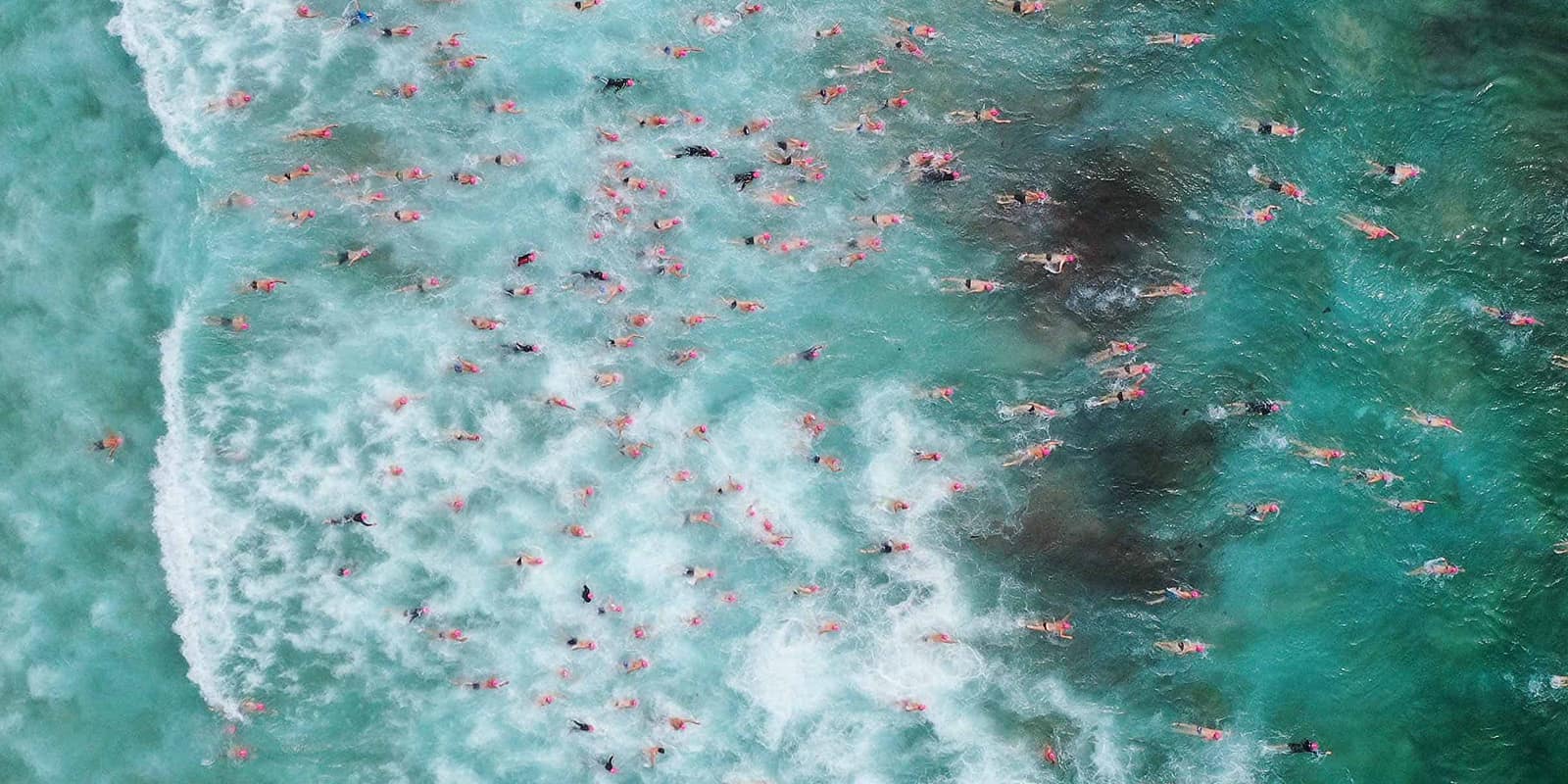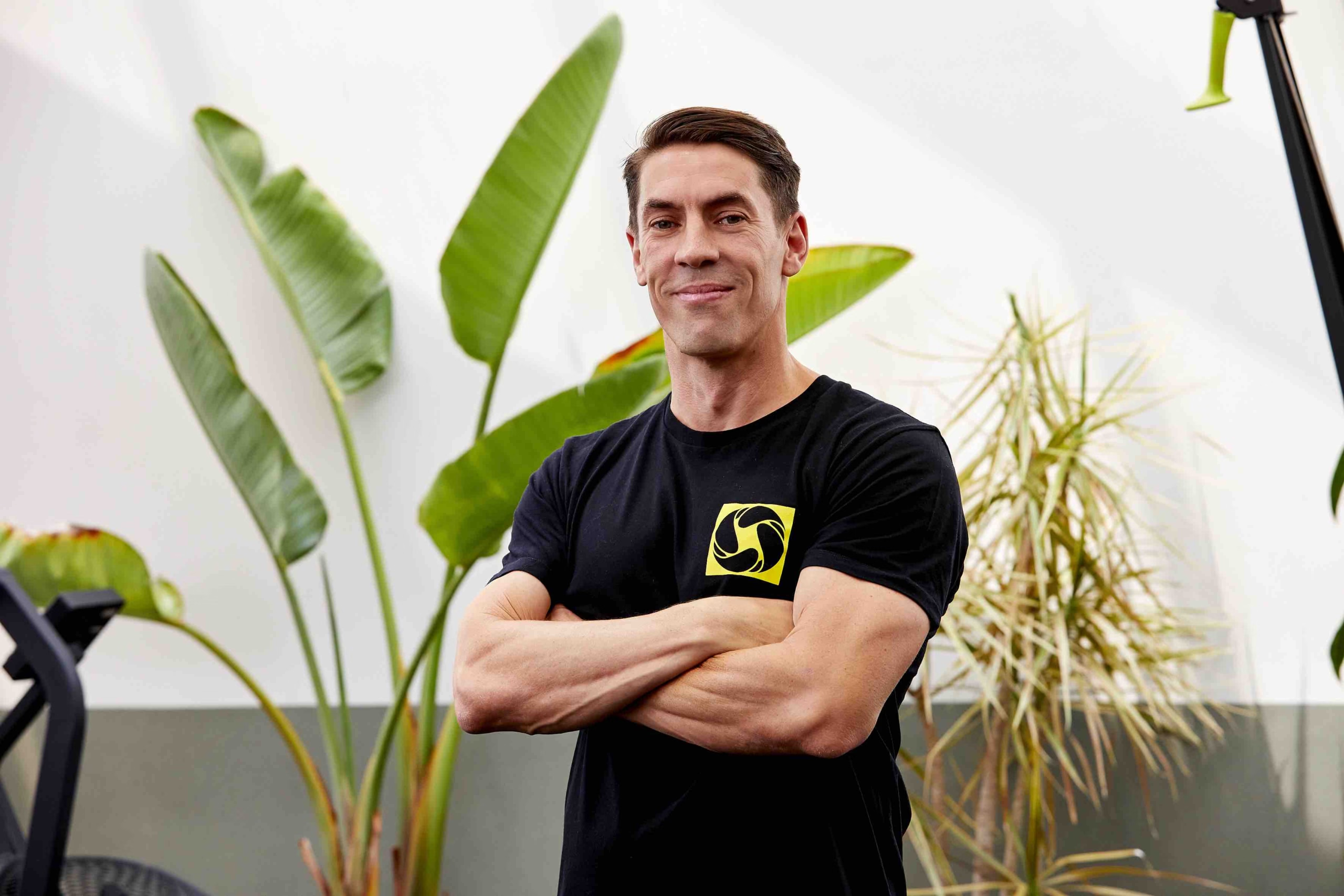Ocean swimming is great, improve yours with our expert tips — from a champion racer, a top coach and an experienced campaigner.
Ocean swimming is one of the fastest-growing sports in Australia. Need evidence? Just click on to oceanswims.com and you’ll find there are races held virtually every weekend in every state throughout the summer — and they fill up soon.
Competitors are attracted to the thrill of exercising in nature, of leaving behind the relative sterility of the lap pool or gym.
If you’ve ever wanted to try an ocean swim, or have entered a couple of events and would like to become better at them, we’ve put together some punchy advice — from a champion open-water swimmer, a top coach and an experienced swim campaigner — to help you swim your best on the day.
We’ve also bundled together a bunch of expert safety tips so you don’t end up swallowing too much salt water or panicking unnecessarily — because, as any experienced ocean swimmer will tell you, feeling confident and comfortable is key to having a good race.
Ocean Swimming: What Is It?
An ocean swimming event usually starts and ends on a beach, often on a Sunday morning. The swims are most commonly run by surf lifesaving clubs to raise funds for their club or local charities, which make them well worth supporting. They’re often around 2km long, but many offer a shorter 1km option to broaden the appeal of the event.
Competitors start on the beach and run into the water once a starting hooter has sounded. A typical ocean-swim course will require competitors to round large inflatable tethered buoys (sometimes referred to as “cans”) before making their way back to shore and finishing the race with a short run up the beach to cross the line. There’s often prize money on offer to the leading male and female swimmers, as well as random lucky dip prizes. Ocean swimming is a pretty pure event — it’s just you, your cossie, goggles and the sea and all its vagaries — but some events, to encourage a wider participation, might include a “wetsuits, flippers, fins and floaties” category, though entrants wearing any of these are not eligible for prizes.
The Start
In ocean swimming, competitors go off in groups (called waves) depending on their age and gender (for example, men aged between 30-39, then 40-49 etc), so don’t be concerned that you’ll be sprinting off the beach at the same time as 2000 other adrenaline-fuelled, sharp-elbowed swimmers. There might be up to 100 in your wave and you’ll all be given a coloured swim cap to wear to differentiate your group from the others. Your wave will gather in a marshalling area near the water’s edge just ahead of your group’s start time. Waves are sent off every four or five minutes by a hooter or whistle. The guns and young ’uns will be in the first wave, with the oldies (usually the slowest, but not always!) making up the final group. Be aware: the start can be a melee of arms and legs as swimmers set course for the first buoy and try to find some clear water to swim in so they can get into a rhythm. Some entrants are more aggressive than others — try not to be and you’ll enjoy the race more.
In Open Water
After the scramble of the start, swimmers usually hope for clean water so that they can get into a rhythm, but although there’s a great sense of freedom associated with punching through the waves with no pool ropes or black lines, this also means that swimmers can end up swimming almost on top of one another. There’s some etiquette to observe here: if you’re a slower swimmer, good etiquette (and a safe option) would be to start at the back of the pack to give yourself more room. If a slower competitor suddenly looms up in front of you, don’t get annoyed that they’re holding you up and swim over the top of them — go around. Generally, be considerate of swimmers around you and try not to be overly aggressive.
The Finish
When you round the last buoy you’re required to and head back to the beach, try to lengthen your stroke. You’ll now be going with the swell, so glide a bit more and let the swell do some of the work.
More experienced swimmers often start looking for waves to catch as they get close to shore. Look behind you as part of your breathing stroke (takes a bit of practice and know-how). Most swimmers will just let the wave wash over them, but if one looks big and intimidating, by all means stop, dive for the bottom and let it pass over you (there isn’t much power in the wave a metre or more below the surface).
The most frequent mistake inexperienced swimmers commit is to stand up too early, in chest- to neck-deep water. Don’t stand until your hand touches the sand while you’re swimming. Practise dolphining and high-stepping your way out of the surf. You can also ride any little waves, or waves that have already broken, behind you: as it begins to hit you, push off the bottom and kick, with your arms straight out in front. The wave should carry you further in. Good surf swimmers can catch and ride a wave until their noses bulldoze the sand.
The Swim Coach
Spot Anderson, 48
Spot, a former world-ranked triathlete, is now head coach at Bondi Fit (bondifit.com), which specialises in training for fun runs, triathlons — and ocean swims. His advice for rookie ocean racers is to practise in the surf to become comfortable with the natural (and frequently changeable) conditions. “It takes four times for rookies to get comfortable out there, and the faster you are, the more options you will have if the sea changes. You’ve also got to practise diving — a lot of guys’ goggles are pushed off when they dive in for the first time, so tighten them beforehand.”
To deal with the intense action at the start of a race, Spot advises beginner ocean swimmers to “work out where they belong in the food chain”. “Start from the back and the side [of your wave] if you lack confidence,” he says. “If you swim in the fast lane at the public pool, go to the front, if you’re in the intermediate lane go to the middle and so on.”
Once you’re stable in the water, have a look for the first buoy and aim to swim 5-10m outside it. “You don’t want to be on the inside with 10-20 people swimming around you — you can get kicked in the head. You should also look up every 10 breaths to make sure you’re on course.”
Spot recommends swimming with a straighter arm to deal with choppy water and to maintain a high stroke rate. To improve stroke rate, tie your ankles together with a band when you’re practising in a pool — it will force you to increase your output.
Although some coaches recommend learning to breath bilaterally (on each side), Spot favours single-side breathing, because you get 50 percent more air.
The Gun
Ali Day, 24
Originally from Kiama in NSW but now based in Mooloolaba on Queensland’s Sunshine Coast, Ali won the Great Australian Swim Series in Sydney Harbour in 2011. Ali’s a seasoned Ironman athlete and competes in ocean swimming to hone his skills for racing in the Kelloggs NutriGrain Ironman Series and at an international level abroad.
Ali’s training requires him to cover the four disciplines of Ironman — swim, board, ski, and run — but on a typical day, he’ll swim 6-7km in a pool with a swim squad. He also values his gym time — 2-3 times a week — and his workouts based on bodyweight exercises. “To grow your fitness, it’s important to do some sort of cross-training or gym work for your ocean swimming,” he says.
Echoing Spot Anderson’s advice, Ali’s tip for novice ocean swimmers is to try to do some of your training sessions out in the ocean, so you can get a feel for the water. “Also, select a race distance that’s within your abilities. You don’t want to stagger away from your first race thinking you’ll never want to do a swim again!
“Also, see if you can find a buddy who swims at around the same speed as you to train with and also swim with in the race. In the race itself, take your time — remember, it’s your first swim, so just build into it. The best advice I can give is to find your own ‘clean’ water to swim in and enjoy the race.”
As a pro, Ali’s tactic for the all-important start is to secure what he considers the best spot on the start line. “I try to position myself closest to the can [first marker buoy]. I also note the conditions — tides, rips, currents and banks — to use these to my advantage. Everybody wants a good start; I try to get an even better one so that I don’t get caught up with other competitors. It’s always good to get your own clean water, so getting away quickly is crucial.”
The Experienced Campaigner
Gary Shiels, 60s
A ski paddler and runner who used swimming as part of a training program, Gary has competed in ocean swimming — in his hometown of Sydney and interstate — for 30 years. Although he modestly claims “to have no memorable results as a swimmer”, it’s as an organiser of major races that Gary has a wealth of experience. He was race director of Sydney’s iconic Cole Classic for many years, as well as several other big swims — and the Uncle Toby’s Superseries (beach ironman racing) for its first three years.
As a competitive ski paddler at the Masters level — Gary medalled at the 2010 World Championships with partner John Cahill in the K2 kayak — he uses ocean swimming as cross-training, putting in three sessions a week of at least 2km of interval training.
His advice for the newbie: gain confidence in the water. “Swim at least three days a week and be confident you can complete the race distance. If your technique is lacking, have swimming lessons and/or style correction. I’ve also always believed that strength training is critical to every sport, improving the body’s ability to perform and recover.
Gary also has sage advice about the start. “Practise swimming the first 200 metres of the race. “If you’re a beginner, follow the rest of the swimmers in your start wave, rather than trying to lead them. The start and the first 200 metres are the most daunting — 70 percent of rescues in ocean swims occur in the first 200 metres. Inexperienced swimmers might not be aware of the mild chaos that occurs. Don’t panic and resort to breaststroke if necessary.”
“Ocean swimming is like anything else we pursue — the better you’re prepared, the more confident you’ll feel and the better you’ll perform.”
Safety Tip 1
Swim with a group or at least one other person. Ideally, they’ll be about the same speed as you so you don’t have to stress about swimming fast enough to keep up. Besides the obvious benefit of this, swimming beside your training partners will make you feel more at ease while you’re in the midst of such an enormous body of water. Plus, when you stop to tread water and look around, you’ll have someone to listen to when you say, “Wow, isn’t this tops?!”
Safety Tip 2
Swim at a beach you know. If you’re new to ocean swimming, ask around about the best places to swim — locals will know. Ideally, the best places will have sandy beaches that make it easy to enter/exit the water, and won’t have strong currents and/or surf. Sometimes the time of year makes a huge difference.
Safety Tip 3
Swim within your ability. If you’re not yet sure about your endurance, be sure to swim only on beaches where there are lifeguards, and stay out of the sea completely until you can swim at least 500-800 metres non-stop and comfortably in a pool.
There are no walls in the ocean and in all likelihood, it’ll be too deep to stand up, so the only ‘rest’ you’ll get while you’re out there will involve treading water or floating on your back.




